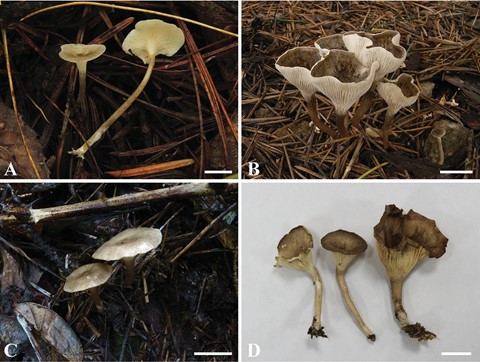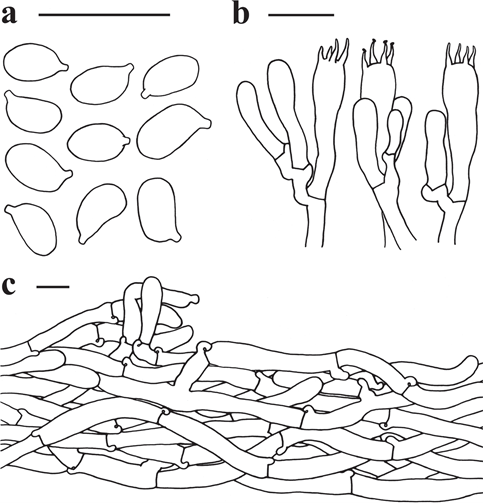Spodocybe rugosiceps Z. M. He & Zhu L. Yang, sp. nov.
MycoBank number: MB 839052; Index Fungorum number: IF 839052; Facesoffungi number: FoF; Figs 4A, B, 5
Diagnosis. Differs from S. bispora in having a rugose pileus, smaller basidiospores and 4-spored rather than 2-spored basidia. Differs from C. trulliformis in having smaller basidiospores and a rugose rather than felty-squamulose pileus.
Etymology. rugosiceps refers to the rugose pileus.
Type. China. Yunnan Province: Kunming City, near Yeya Lake, at 25.136658°N, 102.873027°E, alt. 2000 m, 11 Aug 2020, Z. M. He 72 (KUN-HKAS 112563, holotype).
Description. Basidiomes small, clitocyboid. Pileus 0.5–2 cm in diam, at first nearly applanate, then concave; surface dry and rugose, gray-brown (5E2-4) to gray-black (4F2-4) in the center and gray-brown (5C2-4) or gray (5B1-2) towards margin; center often slightly umbonate; margin straight and undulating; context thin and white (1A1) to cream (1A2). Lamellae deeply decurrent, white (1A1) to cream (1A2), thin (up to 2 mm high), crowded, sometimes forked and intervenose. Stipe 2.5–6 × 0.2–0.4 cm, central, narrowly cylindrical to subcylindrical, sometimes flexuous, hollow; surface dry and nearly smooth, concolorous with pileus; context white (1A1). Basidiospores [60/3/3] 5–6 (6.5) × (2.5)3–3.5(4) μm, Q = (1.38)1.55–1.95(2), Qm = 1.73 ± 0.14, elongate, colorless, hyaline, smooth, thin-walled, inamyloid. Basidia 20–24 × 5–6 μm, clavate, 4-spored, colorless, hyaline, thin-walled; sterigmata up to 4 μm long; ratio of basidia to basidiospore length values about 3–5. Cystidia absent. Lamellar trama subregular; hyphae colorless, hyaline, cylindrical, thin-walled, 3–10 μm wide. Pileipellis a cutis, but in places upright or trichodermial in appearance, made up with thin-walled cylindrical hyphae 3–9 μm wide. Stipitipellis a cutis, composed of thin-walled cylindrical hyphae 3–10 μm wide. Clamp connections present in all parts of basidiome.
Habitat, ecology and distribution. Gregarious or caespitose, growing saprotrophically in forest litter, often under conifers, on the ground, known from subtropical zone of Yunnan, China; from July to October.
Additional specimens examined. China. Yunnan Province: Dali Bai Autonomous Prefecture, Yunlong Country, Tianchi National Nature Reserve, at 25.850365°N, 99.274236°E, alt. 2509 m, 28 Sep 2019, X. H. Wang 7471 (KUN-HKAS 112561); Kunming City, Fangwang Tree Farm, at 25.063737°N, 102.870690°E, alt. 2262 m, 22 Sep 2011, Z. L. Yang 5586 (KUN-HKAS 71071); Kunming City, Kunming Institute of Botany, at 25.147081°N, 102.748855°E, alt. 1990 m, 24 Aug 2020, Z. L. Yang 6391 (KUN-HKAS 112562); Kunming City, Qiongzhu Temple, at 25.071304°N, 102.630934°E, alt. 1900 m, 28 Jul 2013, T. Guo 779 (KUN-HKAS 81981); Yulong Country, Lashi Village, at 26.883902°N, 100.234594°E, alt. 2655 m, 31 Jul 2011, L. P. Tang 1369 (KUN-HKAS 69830).

Figure 4. Basidiomes of described Spodocybe species. A, B Spodocybe rugosiceps (KUN-HKAS 112563, KUN-HKAS 112562, respectively) C, D Spodocybe bispora (KUN-HKAS 73332, KUN-HKAS 112562, respectively). Scale bars: 1 cm.

Figure 5. Microscopic features of Spodocybe rugosiceps (KUN-HKAS 112563, holotype) a basidiospores
b basidia c pileipellis. Scale bars: 10 μm.
